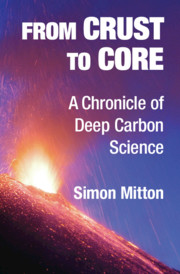Book contents
- From Crust to Core
- From Crust to Core
- Copyright page
- Dedication
- Contents
- Foreword
- Acknowledgments
- Introduction
- 1 Why Carbon in Earth Matters
- 2 The Origin of Deep Carbon in Deep Space
- 3 Deliveries of Cosmic Carbon Continue
- 4 On the Nature of Earth’s Interior
- 5 Earth’s Physical Interior Revealed
- 6 Thousands, Millions or Billions
- 7 Physics and Chemistry of Deep Earth
- 8 Confronting the Continental Drift Conundrum
- 9 The Mid-Atlantic Ridge and Rift Valley
- 10 Earth’s Deep Dynamics Discovered
- 11 Reversals of Fortune
- 12 Deep Carbon
- 13 Carbon-Bearing Phases in the Mantle
- 14 Diamond in the Mantle
- 15 Deep Life
- Glossary
- Biographical Notes
- Index
- References
3 - Deliveries of Cosmic Carbon Continue
Published online by Cambridge University Press: 19 December 2020
- From Crust to Core
- From Crust to Core
- Copyright page
- Dedication
- Contents
- Foreword
- Acknowledgments
- Introduction
- 1 Why Carbon in Earth Matters
- 2 The Origin of Deep Carbon in Deep Space
- 3 Deliveries of Cosmic Carbon Continue
- 4 On the Nature of Earth’s Interior
- 5 Earth’s Physical Interior Revealed
- 6 Thousands, Millions or Billions
- 7 Physics and Chemistry of Deep Earth
- 8 Confronting the Continental Drift Conundrum
- 9 The Mid-Atlantic Ridge and Rift Valley
- 10 Earth’s Deep Dynamics Discovered
- 11 Reversals of Fortune
- 12 Deep Carbon
- 13 Carbon-Bearing Phases in the Mantle
- 14 Diamond in the Mantle
- 15 Deep Life
- Glossary
- Biographical Notes
- Index
- References
Summary
When the formation of the Moon and the phase of giant impacts had mostly run its course, a final round-up of the remaining planetesimals took place. Gravitational forces exerted by the eight planets scoured interplanetary space: some planetesimals were flipped into the Sun, others thumped into terrestrial or giant planets, and the remainder were expelled to interstellar space by gravitational slingshot effects. Unsurprisingly, gravity’s purge of the solar system was not an entirely clean sweep. Comets, asteroids, meteors (meteorites once they make the journey through Earth’s atmosphere) and mere specks of dust lingered. In our age, this debris has become an indispensable archival source of data for revealing how, over billions of years, the elements have been sieved and sorted for distribution throughout the solar system. Detailed investigations of the composition of asteroids and meteorites became a hot area of planetary science research at the beginning of the present century. In 2015, the NASA spacecraft Dawn began a three-year survey mission to Ceres, the largest asteroid.
- Type
- Chapter
- Information
- From Crust to CoreA Chronicle of Deep Carbon Science, pp. 45 - 61Publisher: Cambridge University PressPrint publication year: 2020

